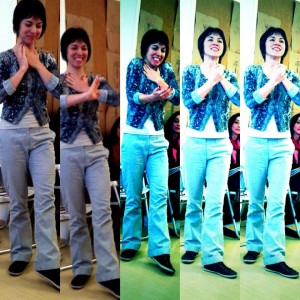Or how students are already using the Formative Process device
Regina Favre and the BS2 Group
Regina: set up the ballerina’s body while saying the instructions… doing and saying… actions and verbs
Student: I don’t know how much I really apply everything that we have experienced here, but there are many issues going through me… I can feel construction happening… I teach classical dance classes and in classical dancing there is a way to do, a correct body, a correct posture, steps, or something to be done precisely… my issue is to keep working on softening, get away from the hardness, the hardened, the already known, to make myself more permeable… Trying out a different body and trying to question myself… seeing how the body pulsates inside the structure of classical ballet and how I can make a different experience possible, one that is not a body stereotype, something ready-made, a form that comes from outside.
How do I build this for me and for the other? And in my dancing too… I don’t work with codification in my dancing… it’s really easy to get attached to a priori techniques… so, in the end, everything becomes somewhat meaningless… kind of without feeling really… kind of empty too… I don’t know how much I’ve gotten away from it… I am living all of this, but they’re questions that I don’t know what to do about, how to develop them…
Regina – What can you do to begin to feel the juice of the classical ballerina in you? What we call juice has to do with the formative liquid in the depths of bodies, remember? Can you, right now, tune into the classical ballerina’s body that you’re talking about? Stand up and show me and the group the classical ballerina body. How do you set up the classical ballerina’s body?
(Student doing it)
There is a very precise description: stretch, shrink, soften… all the instructions to set up the classical ballerina while saying the instructions… doing and speaking… actions and verbs…
Student – straighten up, organize your spine, direct your ischia bones down, top of your head upward, tilt your hips, close your belly, widen the space between your shoulders, bring your gaze towards the horizon, feet planted firm on the floor, keeping the arch active, leg and hip muscles, external rotation of the legs ‘en dehors,’ keeping the projecting force upward… pushing on the floor and growing, fingers and arms, light, round…
R – Now, from within the ballerina position, tune into the ballerina’s juice.
(The student does it)
R – That’s it… see how much expression starts to emerge within this body…
S – the juice is actually quite liquid…
R – out of this juice, this liquid, tune in with a pulse, the liquid pulse… which talks with the firm and the long that is the body of the ballerina. You just set up this firm and long. How does the liquid talk with the firm and long of the ballerina structure?
S – the conversations are tremblings happening in the present.
R – ok, experience these tremblings, these heat sensations.
S – there is also a smile.
R – what is the quality of this smile? Pleasure?
S – yes, pleasure, but also embarrassment.
R – How can you show me the embarrassed ballerina? As if you were to do the choreography of the embarrassed ballerina.
S – hahahahaha (she closes her shoulders and laughs)
R – exactly… keep doing it…
S – the embarrassed ballerina gets startled…
R – Pina Bausch’s dancers all did classical dance for 30 years, they all have classical technique… only later did they go to dance-theater.
(She puts her hands on her face)
R – That’s it, the embarrassed classical ballerina, the smile… she sometimes smiles from pleasure, sometimes just grins… intensify that mouth… keep repeating the mouth of the embarrassed ballerina…
(She does it)
R – more mouth, more mouth, more face…
S – I can’t stay, it’s shaking…
R – how does it shake? The shaking is drawing you upward, how can you begin to go down and experience waves downwards with the shaking… muscle tone decreases with shaking.
S – hahahahaha (sighs)
R – that’s it… more of this ahhhh, more…
That’s it. That’s it… intensify this facial expression… this is a somber expression. Let’s give life to these shoulder movements, trunk movements, over here and over there… sneaking… see, this is a sneaking action… that’s it… see the scene? … moving through ghosts… ghosts of failure, of ugliness, of spoiling… look… it’s happening… that’s it, sneaking… that’s it… squeezing your hands with fear… look… and going through ghosts… that’s it.. it’s over…
S – (she breathes out and laughs) there’s a lot of emotion… and really hard body walls…
R – all of that moves me enormously… if I were in the audience, I would cry.
S – (sighs) … it’s difficult to deal with so much emotion… so much emotion…
(Student and Regina cry together)
R – Ok… this is the teacher for real, the one I spoke about… who can get moved…
S – and the dancer for real…
R – even classical ballerinas can be real.
(Student cries and sits)
São Paulo, November, 2012
